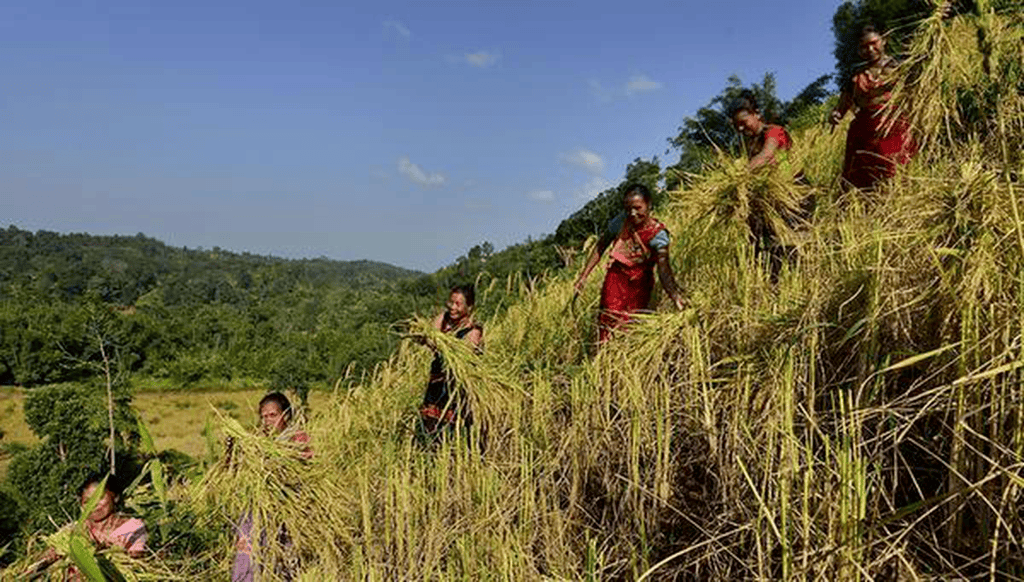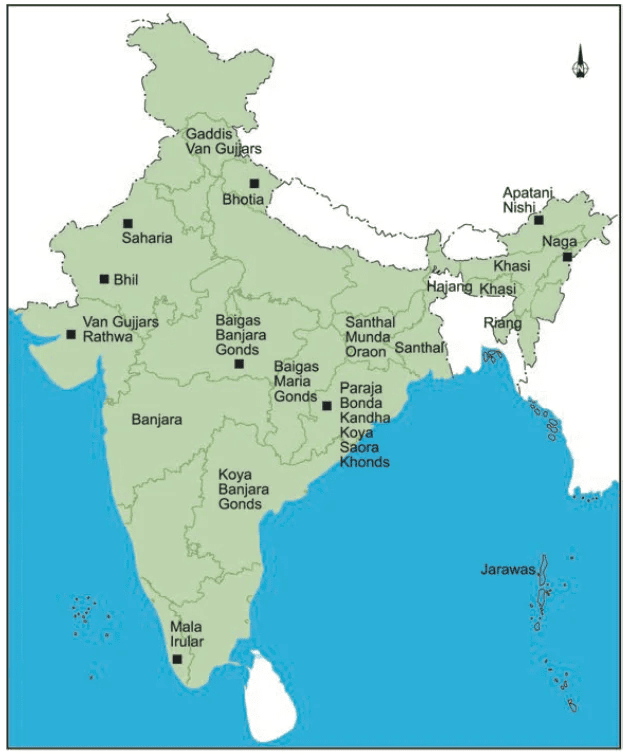Class 8 History Chapter 4 Notes - Tribals, Dikus and The Vision of A Golden Age
| Table of contents |

|
| Who was Birsa Munda? |

|
| How did Tribal Groups Live? |

|
| How did Colonial Rule Affect Tribal Lives? |

|
| A Closer Look |

|
Who was Birsa Munda?
- Roamed Chottanagpur forests and villages in Jharkhand around 1895.
- Known for miraculous powers: curing diseases and multiplying grain.
 Birsa Munda
Birsa Munda
- Declared himself as a savior appointed by God to free his people from the oppression of dikus (outsiders).
- Thousands of people followed him, believing him to be bhagwan (God).

Followers and Tribal Groups:
- Birsa belonged to the Munda tribe.
- His followers included other regional tribes such as Santhals and Oraons.
- Tribes were discontented with changes and challenges under British rule, fearing the loss of their traditional ways of life, livelihoods, and religion.
Key Issues:
- Problems Birsa sought to address: oppression by outsiders (dikus) and the perceived enslavement of tribal people.
- Changes under British rule led to threats to tribal livelihoods and erosion of their religious practices.
Tribal Societies:
- Distinct customs and rituals, different from those prescribed by Brahmanical traditions.
- Lacked the sharp social divisions seen in caste societies.
- Tribes shared common kinship ties, though there were social and economic differences within the tribes.
How did Tribal Groups Live?
By the nineteenth century, tribal people in different parts of India were involved in a variety of activities.
Some were Jhum Cultivators
i) Jhum cultivation, also known as shifting cultivation, was practiced on small patches of land, primarily in forests.
ii) The cultivators cut treetops to allow sunlight to reach the ground and burned the vegetation to clear the land for cultivation.
iii) The ash from the burned vegetation, rich in potash, was spread to fertilize the soil.
 Jhum Cultivation
Jhum Cultivation
iv) Tools like the axe were used to cut trees, and the hoe was used to scratch the soil for cultivation.
v) Seeds were broadcasted by scattering them on the field rather than plowing and sowing them.
vi) After harvesting the crop, the cultivators moved to another field, leaving the previously used field fallow for several years.
vii) Shifting cultivation was common in the hilly and forested areas of north-east and central India.
viii) The livelihoods of these tribal people depended on free movement within forests and the use of land and forests for their crops.
Some were Hunters and Gatherers
i) Hunting and gathering: Tribal groups in many regions lived by hunting animals and gathering forest produce, considering forests essential for survival.
 Hunters
Hunters
ii) Khonds community: The Khonds, a tribal community in the forests of Orissa, conducted collective hunts and shared the meat amongst themselves.
iii) Forest produce: They collected fruits, roots, and extracted oil from seeds like sal and mahua for cooking.
iv) Medicinal use: Forest shrubs and herbs were used for medicinal purposes, and forest produce was sold in local markets.
v) Supplies for weavers: Local weavers and leather workers relied on the Khonds for supplies of kusum and palash flowers to color their clothes and leather.
vi) Barter and earnings: Tribal people obtained rice and grains by exchanging forest produce or purchasing with their small earnings.
vii) Odd jobs: Some tribal people did odd jobs in villages, such as carrying loads or building roads, while others worked in fields.
viii) Reluctance to labor: Tribes like the Baigas of central India were reluctant to work for others, considering it below their dignity to become laborers.
ix) Dependence on traders: Tribals often depended on traders and moneylenders for goods not produced locally, leading to debt and poverty.
x) High-interest loans: Moneylenders charged high interest on loans, causing tribals to view them and traders as evil outsiders responsible for their misery.
 Location of some tribal groups in India
Location of some tribal groups in India
Some herded animals
i) Herding and rearing animals: Many tribal groups lived by herding and rearing animals, practicing a pastoral lifestyle.
ii) Pastoralists: These groups moved with their herds of cattle or sheep according to the seasons, relocating when the grass in one area was exhausted.
 Gujjar-Bakarwals
Gujjar-Bakarwals
iii) Van Gujjars: The Van Gujjars of the Punjab hills and the Labadis of Andhra Pradesh were cattle herders.
iv) Gaddis: The Gaddis of Kulu were shepherds, responsible for herding sheep.
v) Bakarwals: The Bakarwals of Kashmir were known for rearing goats.
Some took to Settled Cultivation
i) Settled cultivation: Many from tribal groups began settling down and cultivating their fields in one place year after year, instead of moving frequently.
ii) Plough usage: They started using the plough and gradually obtained rights over the land they lived on.
 Ploughing
Ploughing
iii) Clan ownership: In many cases, like the Mundas of Chottanagpur, the land belonged to the clan as a whole, with all members having rights as descendants of the original settlers.
iv) Power hierarchy: Within clans, some people acquired more power than others, leading to chiefs and followers. Powerful men often rented out their land instead of cultivating it themselves.
v) British view: British officials considered settled tribal groups like the Gonds and Santhals to be more civilised compared to hunter-gatherers or shifting cultivators, who were seen as wild and savage.
How did Colonial Rule Affect Tribal Lives?
The lives of tribal groups changed during British rule.
What Happened to Tribal Chiefs?
i) Pre-British importance: Tribal chiefs held significant economic power and controlled territories.
ii) Administrative roles: Chiefs had their own police and set local rules for land and forest management.
iii) British changes: Under British rule, chiefs kept their land titles but lost much of their administrative power.
iv) New obligations: They had to follow British laws, pay tribute, and discipline tribes on behalf of the British.
v) Loss of authority: Chiefs lost their traditional authority and could no longer fulfil their earlier roles.
What Happened to the Shifting Cultivators?
 (i) The British were uncomfortable with the shifting cultivators.
(i) The British were uncomfortable with the shifting cultivators.
(ii) The British wanted to regular revenue source for the state and introduced land settlements.
iii) The British effort to settle jhum cultivators was not very successful.
iv) After facing widespread protests, the British had to allow them the right to carry on shifting cultivation in some parts of the forest.
Forests Laws and Their Impact
i) Forest connection: Tribal life was directly connected to the forest, making changes in forest laws impactful.
ii) British control: The British declared forests as state property and classified some as Reserved Forests for timber.
iii) Restrictions: Tribals were restricted from moving freely, practising jhum cultivation, collecting fruits, or hunting.
iv) Forced migration: Many jhum cultivators were forced to move to other areas in search of work and livelihood.
v) Labour issue: The British faced a labour shortage for forest work after restricting tribals from living in forests.
vi) Forest villages: The Forest Department gave tribals small patches of land in exchange for labour and forest management.
vii) Resistance: Tribals resisted forest laws, with revolts like Songram Sangma in 1906 and forest satyagraha in the 1930s.
The Problem with Trade

i) Increased presence: In the 19th century, traders and moneylenders increasingly entered forests to buy forest produce, offer cash loans, and seek labor.
ii) Awareness: Tribal groups took time to understand the consequences of these interactions.
iii) Silk demand: In the 18th century, there was a high demand for Indian silk in European markets, leading to increased exports.
iv) Encouragement: The East India Company officials encouraged silk production to meet the growing demand.
v) Silk growers' plight: In Hazaribagh (Jharkhand), Santhals reared cocoons but received only ₹3 to ₹4 per thousand cocoons. These were sold at five times the price in Burdwan or Gaya.
vi) Middlemen’s profits: Middlemen made large profits by arranging deals between exporters and silk growers, while the growers earned very little.
vii) Tribal resentment: Many tribal groups viewed the market and traders as their main adversaries.
The Search for Work
(i) The plight of the tribals who had to go far away from their homes in search of work was even worse.
(ii) The tribals were recruited in large numbers to work for tea plantations of Assam and coal mines of Jharkhand through contractors low wages, and prevented them from returning home.
 Coal Mines of Jharkhand
Coal Mines of Jharkhand
A Closer Look
Throughout the 19th and 20th centuries, tribal groups rebelled against changes in laws, restrictions on practices, new taxes, and exploitation by traders and moneylenders.
Notable revolts:
- The Kols rebelled in 1831–32.
- The Santhals rose in revolt in 1855.
- The Bastar Rebellion occurred in central India in 1910.
- The Warli Revolt took place in Maharashtra in 1940.
Birsa's movement was part of this broader pattern of tribal resistance.
Birsa Munda
Mid-1870s: Birsa Munda was born into a poor family in Bohonda, Jharkhand, and grew up grazing sheep and engaging in local traditions.
Adolescence: Birsa heard about the Munda uprisings and sirdars urging revolt, aiming to restore ancestral rights and resist dikus (outsiders).
 Postal Stamp in Memory of Birsa MundaMissionary School: Attended a local missionary school, where he learned about attaining the Kingdom of Heaven and the need to abandon “bad practices.”
Postal Stamp in Memory of Birsa MundaMissionary School: Attended a local missionary school, where he learned about attaining the Kingdom of Heaven and the need to abandon “bad practices.”
Vaishnav Influence: Spent time with a Vaishnav preacher, adopting values of purity and piety.
1895: Birsa started his movement, urging the Mundas to return to a golden past of cultivation and community integrity.
Opposition to British: The movement aimed to expel missionaries, moneylenders, and landlords, and establish a Munda Raj.
1895 (Arrest): British arrested Birsa on rioting charges, sentencing him to two years in prison.
1897: After release, Birsa toured villages, rallying support and attacking symbols of diku and European power.
1900: Birsa died of cholera, and the movement declined, but it led to laws protecting tribal land and showed the tribal capacity for protest and self-expression.
|
69 videos|431 docs|46 tests
|
FAQs on Class 8 History Chapter 4 Notes - Tribals, Dikus and The Vision of A Golden Age
| 1. Who was Birsa Munda and what was his significance in Indian history? |  |
| 2. How did tribal groups traditionally live before colonial rule? |  |
| 3. What were the major impacts of colonial rule on tribal lives? |  |
| 4. What was the vision of a golden age as perceived by tribal communities? |  |
| 5. How can we understand the struggles of tribal communities in the context of the broader Indian independence movement? |  |





















